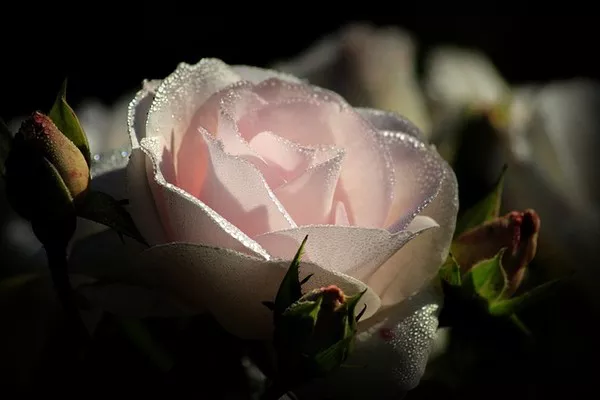Flowers, with their delicate petals and captivating fragrances, have long held a special place in human culture. From ancient rituals to modern-day celebrations, flowers are intertwined with our traditions, emotions, and symbolism. Among the vast array of blooms that adorn gardens and landscapes worldwide, one particular flower stands out as the epitome of beauty, elegance, and significance—the rose.
The Rose: A Timeless Symbol of Love and Beauty
With its rich cultural history spanning millennia, the rose has rightfully earned its status as the most famous flower in the world. Revered for its exquisite beauty and intoxicating scent, the rose holds a prominent place in art, literature, and mythology across various civilizations.
Cultural Significance and Symbolism
Throughout history, the rose has been associated with love, passion, and romance. In ancient Greek and Roman mythology, the rose was linked to deities such as Aphrodite and Venus, symbols of love and beauty. The rose’s association with romance endured through the ages, becoming a universal symbol of affection and desire.
In addition to its romantic connotations, the rose carries diverse cultural meanings. In Christianity, the red rose is often seen as a symbol of martyrdom and sacrifice, associated with the Virgin Mary and the blood of Christ. In Islam, the rose symbolizes beauty, purity, and the divine. Across various cultures, the rose is also revered as a symbol of renewal, hope, and resilience.
Historical Origins and Evolution
The cultivation of roses dates back thousands of years, with evidence of their presence found in ancient civilizations such as Mesopotamia, Egypt, and China. The earliest known cultivated roses were likely simple, single-petaled varieties with a subtle fragrance. Over time, through selective breeding and hybridization, a diverse array of rose cultivars emerged, showcasing a stunning range of colors, shapes, and fragrances.
The popularity of roses soared during the Roman Empire, where they were used extensively in ceremonies, festivals, and decorative arts. Roses were also prized for their medicinal properties, with extracts used to treat various ailments.
During the Middle Ages, the cultivation of roses flourished in Europe, particularly in monastic gardens. Roses were cultivated not only for their beauty but also for their symbolic significance in religious and courtly contexts. The rose became a prominent motif in medieval art and literature, embodying themes of love, purity, and spirituality.
Varieties and Cultivation
Today, there are thousands of rose varieties cultivated worldwide, encompassing a diverse range of species, hybrids, and cultivars. From the classic hybrid tea roses to the wild and whimsical floribundas, each rose variety offers its own unique charm and character.
Roses thrive in a variety of climates, from temperate regions to subtropical zones. They are cultivated in gardens, parks, and commercial flower farms, providing a continuous supply of blooms for floral arrangements, perfumes, and medicinal products.
The Language of Roses: Communication through Flowers
One of the most intriguing aspects of roses is their ability to convey complex emotions and messages through symbolism. In Victorian-era England, where strict social norms limited verbal expression of emotions, the language of flowers, or floriography, became a popular means of communication. Each color and variety of rose carried its own symbolic meaning, allowing individuals to express sentiments of love, friendship, or condolence through floral arrangements.
Red roses, with their deep, passionate hue, symbolize love and desire, making them a classic choice for romantic gestures. White roses, representing purity and innocence, are often chosen for weddings and religious ceremonies. Yellow roses convey friendship and joy, while pink roses symbolize admiration and gratitude. The symbolic significance of roses continues to resonate in modern culture, where they remain a popular choice for expressing heartfelt sentiments on special occasions.
Roses in Art, Literature, and Popular Culture
The enduring allure of roses is reflected in their frequent depiction in art, literature, and popular culture. From Renaissance paintings adorned with intricate floral motifs to Shakespearean sonnets extolling the beauty of the rose, this iconic bloom has inspired countless artists, poets, and writers throughout the ages.
In addition to its portrayal in high art and literature, the rose has also permeated popular culture, appearing in films, music, and fashion. Its timeless appeal and universal symbolism continue to captivate audiences worldwide, cementing its status as the ultimate symbol of beauty and romance.
Conservation and Preservation Efforts
Despite its enduring popularity, the rose faces threats from habitat loss, climate change, and pests and diseases. To ensure the preservation of this iconic flower for future generations, efforts are underway to conserve wild rose species and promote sustainable cultivation practices.
Botanical gardens and arboreta play a crucial role in preserving rare and endangered rose species, conducting research and conservation initiatives to safeguard genetic diversity. Additionally, initiatives aimed at promoting organic farming practices and reducing chemical inputs in rose cultivation are helping to mitigate the environmental impact of commercial rose production.
Conclusion
The rose, with its timeless beauty and rich symbolism, transcends cultural boundaries and speaks to the universal human experience. From ancient civilizations to modern-day society, the rose has captured the imagination and inspired countless generations with its elegance, fragrance, and profound symbolism. As we continue to cherish and cultivate this iconic flower, let us also strive to preserve its natural heritage and ensure that its beauty endures for generations to come.


